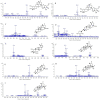Variation of Saponins in Sanguisorba officinalis L. before and after Processing (Paozhi) and Its Effects on Colon Cancer Cells In Vitro
- PMID: 36558181
- PMCID: PMC9785891
- DOI: 10.3390/molecules27249046
Variation of Saponins in Sanguisorba officinalis L. before and after Processing (Paozhi) and Its Effects on Colon Cancer Cells In Vitro
Abstract
The incidence of colon cancer is increasing year over year, seriously affecting human health and quality of life in recent years. However, traditional Chinese medicine (TCM) has been utilized for the treatment of colon cancer. S. officinalis Saponins (S-Saponins), the potential compound of TCM, displays multiple biological activities in colon cancer treatment. In our study, ultra-high-performance liquid chromatography-tandem mass spectrometry (UHPLC-MS/MS) combined with multivariate statistical analysis were performed to analyze and identify raw and processed saponins. Then, MTT and cell migration assays were used to preliminarily explore the effects of saponins in vitro on colon cancer cells. The results showed that 29 differential saponins compounds under Paozhi were identified by UHPLC-MS/MS. Moreover, in vitro validation showed that Sprocessed better inhibited the proliferation and migration of colon cancer cells than Sraw. This study provides a basis for the determination of the chemical fundamentals of the efficacy changes during Paozhi through inferring the changes in saponin components and its possible transformation mechanisms before and after processing S. officinalis. Meanwhile, it also provides new insights into potential bioactive ingredients for the treatment of colon cancer.
Keywords: UHPLC-MS/MS; activity study; content determination; potential ingredients; qualitative analysis; traditional Chinese medicine.
Conflict of interest statement
The authors declare no conflict of interest.
Figures











Similar articles
-
Pharmacokinetics of four tannin compounds from Sanguisorba officinalis L. before and after processing by ultra-high-performance liquid chromatography-tandem mass spectrometry.J Sep Sci. 2024 Feb;47(4):e2300803. doi: 10.1002/jssc.202300803. J Sep Sci. 2024. PMID: 38403460
-
A rapid and sensitive UHPLC-MS/MS method for the determination of ziyuglycoside I and its application in a preliminary pharmacokinetic study in healthy and leukopenic rats.Biomed Pharmacother. 2020 Mar;123:109756. doi: 10.1016/j.biopha.2019.109756. Epub 2019 Dec 25. Biomed Pharmacother. 2020. PMID: 31864212
-
Simultaneous Determination and Pharmacokinetics Study of Three Triterpenes from Sanguisorba officinalis L. in Rats by UHPLC-MS/MS.Molecules. 2022 Aug 24;27(17):5412. doi: 10.3390/molecules27175412. Molecules. 2022. PMID: 36080179 Free PMC article.
-
Phytotherapeutic Activities of Sanguisorba officinalis and its Chemical Constituents: A Review.Am J Chin Med. 2018;46(2):299-318. doi: 10.1142/S0192415X18500155. Epub 2018 Feb 12. Am J Chin Med. 2018. PMID: 29433389 Review.
-
Advancements and challenges in pharmacokinetic and pharmacodynamic research on the traditional Chinese medicine saponins: a comprehensive review.Front Pharmacol. 2024 May 7;15:1393409. doi: 10.3389/fphar.2024.1393409. eCollection 2024. Front Pharmacol. 2024. PMID: 38774213 Free PMC article. Review.
Cited by
-
The processed Sanguisorba officinalis L. triterpenoids prevent colon cancer through the TNF-α/NF-κB signaling pathway, combined with network pharmacology, molecular simulation dynamics and experimental verification.Front Immunol. 2025 Jun 18;16:1605326. doi: 10.3389/fimmu.2025.1605326. eCollection 2025. Front Immunol. 2025. PMID: 40607420 Free PMC article.
References
-
- Pallag A., Roşca E., Tit D.M., MuŢiu G., Bungău S.G., Pop O.L. Monitoring the effects of treatment in colon cancer cells using immunohistochemical and histoenzymatic techniques. Rom. J. Morphol. Embryol. Rev. Roum. Morphol. Embryol. 2015;56:1103–1109. - PubMed
MeSH terms
Substances
Grants and funding
- 2019, No. 5/Heilongjiang Touyan Innovation Team Program
- No. 1573551/National Natural Science Foundation of China
- No. LC2015031/Natural Science Foundation of Heilongjiang Province
- No. 018RCD03/Excellent Innovative Talents Support Program of Heilongjiang University of Chinese Medicine
- No. LBHQ16214/Project of Heilongjiang Province post-doctoral grant
LinkOut - more resources
Full Text Sources

